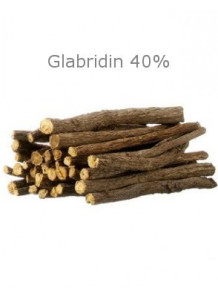Hi-Glabridin™ Licorice Extract (Glabridin 40%)
- Product Code: 1503
Glabridin, extracted from Licorice, is a widely accepted substance. that it has whitening, anti-irritation, anti-aging effects
Type: Glabridin 40% ( Licorice PT40)
- -
- -
- -
- -
- -
- -
- -
- -
- -
- -
- -
- -
- -
- -
- -
- -
- -
- -
| Test Name | Specification |
|---|---|
| Assay | 40% Minimum |
| Appearance | Brown Powder |
| Solubility | Soluble in Ethanol or Butylene Glycol |
| Loss on Drying | 5.0% Max |
| Sulfated Ash | 0.5% Max |
| Heavy Metals | 10ppm Max |
| Arsenic (as As) | 2ppm Max |
| Lead (as Pb) | 10ppm Max |
| Total Plate Count | 100CFU/g Max |
| Yeast & Mold | 10CFU/g Max |
| Escherichia Coli | Negative |
| Staphylococcus Aureus | Negative |
| Salmonella | Negative |
Glabridin, extracted from Licorice, is a widely accepted substance. that it has whitening and anti-irritation effects
This type is sold It is the type that has at least a 40% concentration of the active substance Glabridin. It is popularly called Licorice PT40.
Summary of research results Efficiency in each aspect of Glabridin :
1. Anti-Irritation: Downregulation of iNOS and elevation of cAMP mediate the anti-inflammatory effect of glabridin in rats with ulcerative colitis.
2. Whitening: Inhibitory mechanisms of glabridin on tyrosinase.
3. Whitening / Anti-Irritation: The inhibitory effect of glabridin from licorice extracts on melanogenesis and inflammation.
Instructions for mixing Glabridin in any formula
Glabridin can only be dissolved in Butylene Glycol or Ethanol . It cannot be dissolved in oil or water. The formula therefore needs to have Butylene Glycol or Ethanol in an amount at least 10 times that of Glabridin.
For example, if Glabridin is used at 0.1% it should be Butylene Glycol or Ethanol at least 1% In mixing, take Glabridin and dissolve it with Butylene Glycol or Ethanol You can use heat at 50-60 degrees to help dissolve faster and easier. When melted together well So gradually add it to the last part of the formula. Blend to suit the recipe.
If Glabridin is not completely dissolved, there will be no efficacy in the formulation.
Usage: Can be used in all skin care formulas.
Mixing method: Dissolve in Butylene Glycol or Ethanol. Can withstand heat not exceeding 60 degrees.
Usage rate: 0.02-0.1%
Product appearance: Brown powder
Solubility: Can dissolve in Butylene Glycol or Ethanol.
Storage: Can be stored at room temperature. Close the bottle cap tightly. Then completely protected from sunlight or heat. The product has a minimum shelf life of 2 years.
INCI Name : Licorice (glycyrrhiza inflata) Root Extract
Content: Glabridin 40%
Be the first to review this product :-)
Recent dicussion threads:
- › 2023-01-15 Can you recommend SunScreen?
Example recipes using this ingredient:
- › lock_outlineLICORICE PLUS REITOL NIGHT CREAM
- › lock_outlineABSOLUTE NIGHT SERUM
- › lock_outlineActiv ING 0.6
- › lock_outlineDrV Premire serum
Recommend Lab-Service
| Lab Service | Price |
|---|
Glabridin, extracted from Licorice, is a widely accepted substance. that it has whitening, anti-irritation, anti-aging effects
Type: Glabridin 40% ( Licorice PT40)
Glabridin, extracted from Licorice, is a widely accepted substance. that it has whitening and anti-irritation effects
This type is sold It is the type that has at least a 40% concentration of the active substance Glabridin. It is popularly called Licorice PT40.
Summary of research results Efficiency in each aspect of Glabridin :
1. Anti-Irritation: Downregulation of iNOS and elevation of cAMP mediate the anti-inflammatory effect of glabridin in rats with ulcerative colitis.
2. Whitening: Inhibitory mechanisms of glabridin on tyrosinase.
3. Whitening / Anti-Irritation: The inhibitory effect of glabridin from licorice extracts on melanogenesis and inflammation.
Instructions for mixing Glabridin in any formula
Glabridin can only be dissolved in Butylene Glycol or Ethanol . It cannot be dissolved in oil or water. The formula therefore needs to have Butylene Glycol or Ethanol in an amount at least 10 times that of Glabridin.
For example, if Glabridin is used at 0.1% it should be Butylene Glycol or Ethanol at least 1% In mixing, take Glabridin and dissolve it with Butylene Glycol or Ethanol You can use heat at 50-60 degrees to help dissolve faster and easier. When melted together well So gradually add it to the last part of the formula. Blend to suit the recipe.
If Glabridin is not completely dissolved, there will be no efficacy in the formulation.
Usage: Can be used in all skin care formulas.
Mixing method: Dissolve in Butylene Glycol or Ethanol. Can withstand heat not exceeding 60 degrees.
Usage rate: 0.02-0.1%
Product appearance: Brown powder
Solubility: Can dissolve in Butylene Glycol or Ethanol.
Storage: Can be stored at room temperature. Close the bottle cap tightly. Then completely protected from sunlight or heat. The product has a minimum shelf life of 2 years.
INCI Name : Licorice (glycyrrhiza inflata) Root Extract
Content: Glabridin 40%
| Mechanism | - |
| Appearance | - |
| Longevity | - |
| Strength | - |
| Storage | - |
| Shelf Life | - |
| Allergen(s) | - |
| Dosage (Range) | - |
| Recommended Dosage | - |
| Dosage (Per Day) | - |
| Recommended Dosage (Per Day) | - |
| Mix Method | - |
| Heat Resistance | - |
| Stable in pH range | - |
| Solubility | - |
| Product Types | - |
| INCI | - |
Cart
No products



